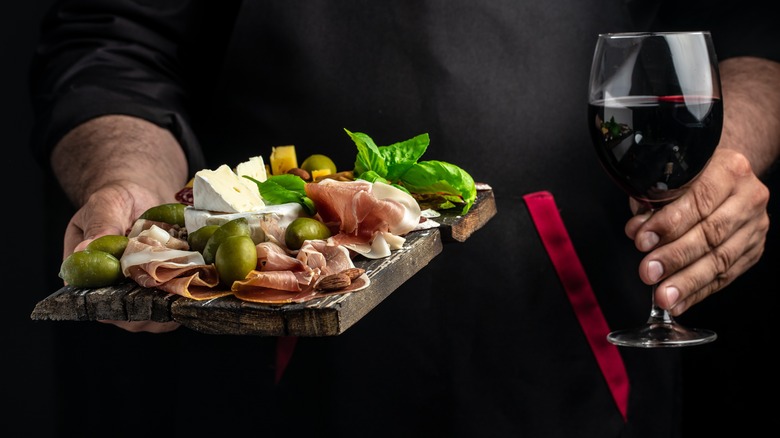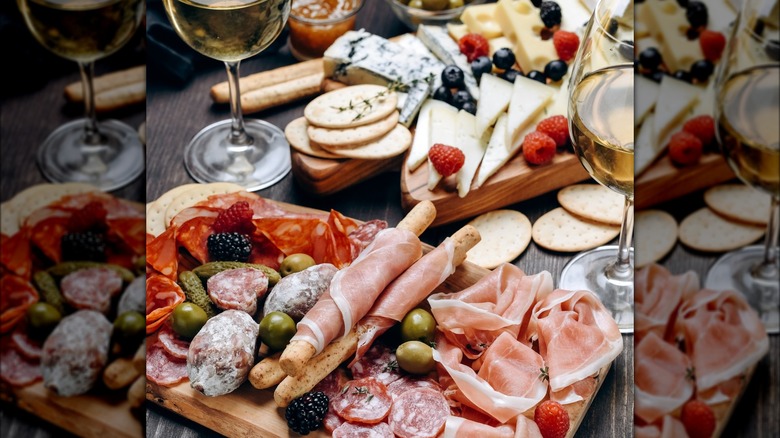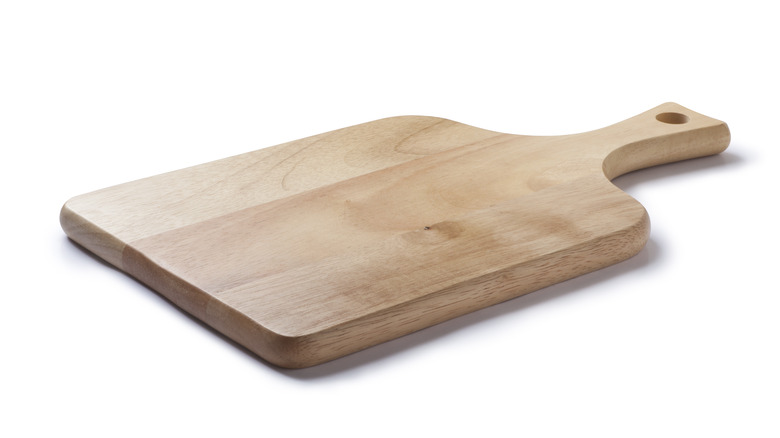The Benefits Of Plating Meals On Serving Boards
The next best dish you serve or consume may not be plated on an actual plate. In fact, there are plenty of reasons why it shouldn't: Plates are heavy and cumbersome, they take up space in your cabinets and build up in your sink, and whether they're disposable or not, you have to deal with them when your meal is done. Fortunately, there's a simple and elegant solution: Plate on a serving board instead of dishes.
The idea of pairing food with a chunk of wood is not new. Cheese and charcuterie boards are as trendy as ever, and the idea of cooking meat on wood dates back to the Native Americans, according to Food Network. The use of wooden boards also remains a popular choice for dishes like salmon grilled on a cedar plank. Not only that, but boards have the additional bonus of protecting your countertop during prep, and additionally help home chefs worldwide maintain a sanitary cooking space. Here's why their role in the meal doesn't have to end once the vegetables are chopped or the protein's been grilled.
All aboard for fun eats
Eating is a historically communal affair. Michael Pollan's book "Cooked" posits that our love for preparing and sharing food sparked human society, and even now and reconnects us with what we eat. According to Pollan, when everyone gets served their own separate plate of food — even food from the same meal — they're staring down at a microcosm that ultimately divides their attention and disengages them from their surroundings. That being said, a serving board can serve as an antidote: Introducing a big board at a dinner party encourages diners to actively take food from the same space, interact with the meal, and therefore each other.
In addition to the benefit of socialization, presentations on a board can, by and large, be bold, beautiful, and simple to accomplish. This type of service evokes a banquet-like and festive atmosphere — it's perfect for occasions like the holidays. Likewise, chefs can relax knowing that providing a plethora of snackables or one big meal to the whole group is easier than tediously replicating each serving. How do they know their guests can or will even eat everything plated, or if they'll even like all that's there? Let them gather around the board and explore its offerings. They don't have to pick anything out of a plated dish and the portion they want is right in front of them.
Cleaning up a serving board is a breeze
Perhaps the most alluring argument for serving a meal off a board is how it simplifies the most dreaded kitchen chore: washing dishes. Rather than winding up with a sink filled with dirty plates and silverware, you only have to deep-clean your board (and perhaps a few utensils like spreaders or tasting spoons) rather than endure a massive clean-up post-party. Larger boards catch messes, so crumbs and spills find their way to your tabletop less often, facilitating surface wipe-downs. If you're chopping or serving up particularly juicy ingredients, like tomatoes or fruit, get into the groove — the juice groove, that is, per The New York Times.
Indeed, you can put virtually anything on a board (well, we don't recommend soup, unless it's in a bowl already). Even a humble platter of pasta can be made more interactive with a couple of well-placed ramekins of sauce, herbed oil, and cheese for hungry folks to enjoy on their terms. As the Food Network noted, a cutting board is a practical shortcut worth leaning on. We all have enough on our plates. Why not ease some of the pressure and try eating off a serving board?


